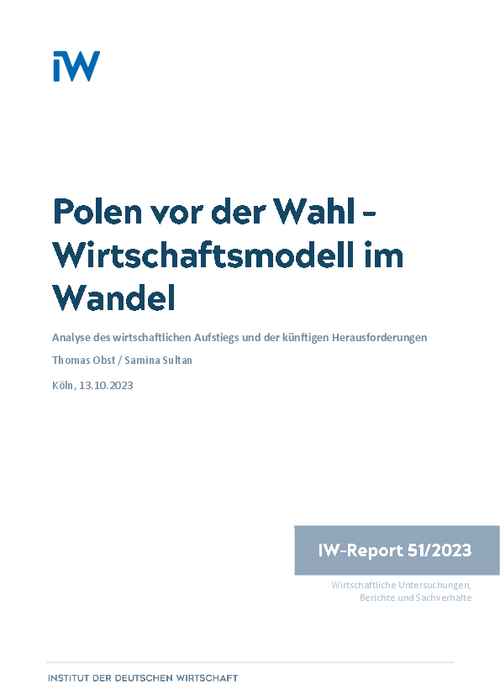On 15 October 2023, the Polish people will elect a new government. The outcome of this election and the further economic development of the country is also relevant for Europe and in particular for the immediate neighbouring countries, such as Germany.

Poland before the election – Economic model in transition

On 15 October 2023, the Polish people will elect a new government. The outcome of this election and the further economic development of the country is also relevant for Europe and in particular for the immediate neighbouring countries, such as Germany.
This is because Poland is now closely intertwined across regions, for example through trade relations. Poland's trade volume rose sharply between 1990 and 2023. Germany is the country's most important trading partner, accounting for 27 per cent of Poland's trade volume. As a dynamically growing economy, the country has also advanced to become an important industrial location in the center of the European Union.
Since the fall of the Iron Curtain in 1989, Poland has undergone a comprehensive social and economic transformation and a rapid economic rise. Per capita economic output has nearly quadrupled from $10,000 in 1991 to about $37,000 in 2022, which is unprecedented in Europe. Despite significant budget deficits, high economic growth has kept government debt in Poland moderate, with the result that the debt ratio in Poland is well below the EU average. In addition, the unemployment rate has reached an all-time low. However, like its European neighbours, the country faces a demographically induced shortage of skilled workers. This is primarily due to low birth rates, an aging population, but also due to the continued high emigration of well-educated workers. At the same time, however, emigration has contributed to a decline in high unemployment in the 2000s and has led to significant remittances from abroad to Poland. However, the share of remittances in Polish GDP has declined sharply and plays a minor role compared to foreign direct investment.
Overall, Poland has become an attractive investment location. However, in the absence of further gains in labour productivity, for example through targeted recruitment of skilled workers, the country could lose an important competitive advantage in the future. The previous recipe for success of increasing qualification and tertiary education of the domestic labour supply could reach its limits. New challenges are also posed by the war in Ukraine and its impact on energy prices and supply chains. So far, the Polish government has been able to cushion the burdens through government measures, but these reliefs expire at the end of 2023. The double-digit inflation rate is also putting the Polish central bank under pressure. The high key interest rates of 6.75 per cent are currently dampening the economic outlook.
A specific success factor for this unprecedented transformation from a planned economy to a full market economy was the embedding of economic liberalisation in stable democratic institutions. As a catalyst and anchor for critical market reforms and institutional transformation, the EU has played a very significant role. Financial resources from the EU budget have also played a decisive role in the expansion of infrastructure in Poland. The second positive factor is the intensification of education. Combined with low labour costs and liberal labour market policies, this has attracted foreign companies to outsource their labour-intensive production steps to Poland. Increasingly, Poland has been able to integrate itself into global, especially European value chains. Complete integration into the European internal market through accession to the EU in 2004 gave this development a decisive boost. The export structure is relatively diversified, which reduces susceptibility to shocks in individual sectors. Despite rising unit labour costs, Poland has been able to improve its position in international competition by devaluing its own currency and thus strongly increase exports in the last decade. As a second pillar alongside its export orientation, Poland can rely on relatively strong domestic consumption, which provides stability especially in a weaker global economy. The particular dynamism of industrial production is another specific success factor of the Polish economic model.
As a high-income country, however, the country is now at a crossroads, as maintaining dynamic growth at this level will require greater efforts. Structural challenges on this path include increasing innovative strength, for example through targeted training and investment in research and development, mastering the green transformation, especially by reducing dependence on coal and expanding renewable energies, and improving the investment climate. Above all, this requires stability, reliability and transparency, for example in investment protection and legal certainty. The Polish government should be just as pragmatic about reforms here as it has been in the past. This would also ease tensions with the European Commission in this area and create the preconditions for the disbursement of financial resources from the EU's reconstruction fund. Given the numerous challenges and investment needs, these funds would be of great benefit to Poland and could also provide incentives for necessary reforms.

Poland before the election – Economic model in transition

More on the topic
![[Translate to English:] Das Gebäude des Weißen Hauses in Washington, D.C. in den Vereinigten Staaten von Amerika. [Translate to English:] Das Gebäude des Weißen Hauses in Washington, D.C. in den Vereinigten Staaten von Amerika.](/fileadmin/_processed_/c/1/csm_GettyImages-2161499385_White_House_Editorial_884306add8.jpg)
Trump or Harris or ...? What Europe must prepare for
A few months before the presidential election in the USA, Donald Trump has a good chance of being re-elected. On the Democratic side, the incumbent president has withdrawn his candidacy after a long period of hesitation, while Vice President Kamala Harris is ...
IW
Compendium 5.5: CO2 Regulation of Road Transport in Europe
With the Compendium CO2 Regulation in Europe, the IW has been providing the interested public with a comprehensive collection of data on the development of CO2 emissions from passenger car traffic in the European Union, as well as on the applicable regulatory ...
IW